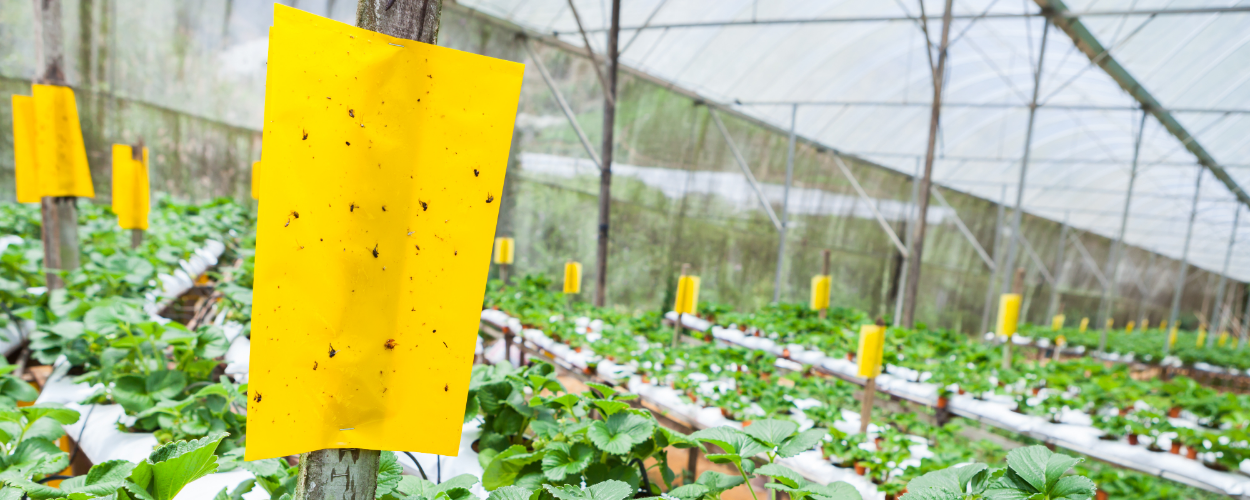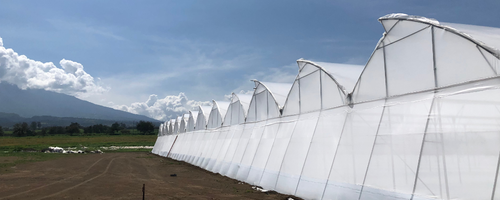
7 pests to exclude with insect nets (and 1 pollinator to care for) – a greenhouse grower's guide

There are seven insects you will want to keep out of your greenhouse when you’re growing in hot and arid or hot and muggy parts of the world. Most of these insects like it hot, especially if it means they can live through a warmer winter and get a jumpstart on the spring breeding season.
But one of them is an insect that you will want very much want inside your greenhouse. It doesn’t like it too hot and can go on strike if temperatures get too high, or if humidity makes plants too sticky. I’m guessing you already know which insect this is, but if not, stay tuned. All will be revealed.
In this article
1 Western Flower Thrip (Frankliniella Occidentalis)
2 Silverleaf Whitefly (Bemisia Argentifolii)
3 Greenhouse Whitefly (Trialeurodes Vaporariorum)
4 Melon Aphid (Aphis Gossypii)
5 Green Peach Aphid (Myzus Persicae)
6 Serpentine Leafminer (Liriomyza Trifolii)
7 Asian Citrus Psyllid (Diaphorina Citri)
Table: Seven pests and key issues and appropriate insect nets
Five common questions about insect exclusion
Thrips came in at the top of our list, when Svensson’s team of consultants discussed which insects to include in this list.
I spoke with Ying Ying and Nelson Pérez to learn more about their insect control experiences and together we created this updated Svensson insect control guide, with a focus on warmzones growing. They’re fellow Climate Consultants and blog authors in China and Spain respectively.
They’ve added their experiences among the descriptions of pests. Here you can learn more about the Svensson insect nets you can use to combat them, including the mesh size that is relevant, given their abdominal diameter.
Top seven insects to exclude from your greenhouse in warm regions
1 Western Flower Thrip (Frankliniella Occidentalis)

Photo by: Alton N. Sparks, Jr., University of Georgia, Bugwood.org
If you are growing in a hot climate, and especially if your greenhouses are near to agricultural crops like corn, then the word thrip may really get you going.
Thrips aren’t just tiny, they bring viruses with them. Add to that the challenge of finding them once they’re on your plants (they are really, really small!) and you don’t want them in your greenhouse in the first place.
The Western Flower Thrip, to give it its full title, is a tiny, slender insect with a critical dimension (it’s abdominal cross-section) of 192 µm. In Integrated Pest Management (IPM) these days, they're at the top or close the top of many grower's most wanted list.
These pests are notorious for causing damage by feeding on plants, especially flowers. They possess rasping-sucking mouthparts, allowing them to pierce plant tissues and suck out cell contents, leading to stippling, distorted growth, and reduced flower quality.
Employing insect netting solutions can effectively control their entry and mitigate the associated economic losses.
Case study: Growers tackle thrips in México
Working with Inveragro in the valley of San Felipe, Guanajuato here in Mexico was an interesting case because what set out as an insect control project led to several different cost reductions, and a better growing environment.
Thrips and Whitefly had been a problem for the grower at the time, Germán Sandoval Barba. He was looking after a 10-hectare pepper greenhouse. The greenhouse has been in operation for about five years now, but when I visited the project in 2022 the goal was to improve pest control and increase humidity. Peppers like it humid, but as soon as we pulled in to San Felipe you could feel the dry air. Relative humidity was less than 20%. For peppers that’s going to be an issue; they want 60-70% RH.
Worried that the crop would pay a heavy price in terms of higher temperatures when we added nets to the greenhouse, Germán was relieved after seeing how the windows could be left open, keeping temperatures down while raising humidity to 10 to 15%.
The spread of thrips in the greenhouses at San Felipe meant that pesticides were being applied before the growers added in beneficial insects. That meant that the Orius that was being introduced to prey on the thrips was being damaged by the earlier application.
Germán told me on a later visit that he had been able to dramatically reduce applications. He was actually able to modify the program and rely on three instead of four Orius per square meter. Applications for powdery mildew were also cut in half, reducing costs.
"Now I can release the biological control insects without pesticides and/or agrochemicals applications that could damage the biological control program."
Germán said that growers tend to worry a bit too much that insect nets will damage their climate:
"What it can generate in the climate is minimal and what it can help them in the phytosanitary issue is very broad, the net pays for itself."
Case study: A grower’s meticulous trials and proven successes with thrips in China
We conducted a trial in China which Ying designed with Han Mingjun, the founder of Rong Rong farms near Yuxi, in Yunnan Province in Southwest China. It shows how an ambitious grower can get an infestation thoroughly under control.
Han Mingjun was frustrated that pests were coming from the nearby open fields and bringing Tomato Spotted Wilt Virus. It was costing his operation both yield and quality.
"If we can control them and lower the incidence, we know we’ll see a much better crop," he told Ying at the time.
With the growers, she ran a side-by-side trial, and there’s a whole article and even a film about that at the link above.
Ying loves data trials. Take a look at the schematic Rong Rong created during the trial. The chart shows a greenhouse using the grower’s previous choice of insect netting, compared to a house with Xsect installed. I hope this gives a sense of the difference that using a Svensson insect screen can achieve. It’s so great to see the pest incidence, recorded by meticulous sampling by the growers, mapped out over time.
What I think is so cool about the schematic is that you can even see the impact when there were some issues with the greenhouse door on house number 4 (the one with the Svensson Xsect screen).
It meant a slight ingress of thrips from week 20 (see the red arrow). Fortunately it clears up after a week or two.

Five weeks of side-by-side, sector by sector insect presence data from greenhouse 4 (Xsect Xtra installed) and greenhouse 6 (previous standard insect net installed
Pests 2 and 3: Whitefly, including Silverleaf and Sweetpotato Whitefly (Bemisia Argentifolii and Bemisia Tabaci) and Greenhoues Whitefly (Trialeurodes Vaporariorum)

Photo by: Scott Bauer, USDA Agricultural Research Service, Bugwood.org

Photo by: Whitney Cranshaw, Colorado State University, Bugwood.org
The Silverleaf Whitefly, with a critical dimension of 239 µm, poses a significant threat to greenhouse crops. These tiny, winged insects are known for their rapid reproduction and ability to transmit plant viruses.
They feed on plant sap, causing wilting, yellowing, and the development of sooty mold.
Nelson Pérez told me that his work with CristalPlant Group left a very strong impression. Aphid, thrips and Silverleaf whifefly were issues when he first started working with the company.
Cristalplant grows horticultural and ornamental plants and was one of the first seedling growers to offer first Global Gap certification and later CAAE certification for organic production.
Nelson told me: "It was a proud moment when Laura González, their Director of Production, showed me around after they’d installed Xsect Xtreme and Xsect Xtra insect screens."
The Almeria and Motril region, with all its horticulture, had a very high pest infestation, mainly thrips, whiteflies, red spider mite and aphids. They saw fantastic results, reduced pesticide use by 90%, and were over the moon that they had no incidence of virus.
With a critical dimension of 288 µm, #3, Greenhouse Whitefly (Trialeurodes Vaporariorum) are a common pest affecting greenhouse crops. They feed on plant sap, causing leaf yellowing, wilting, and a decrease in overall plant health. These insects also excrete honeydew, promoting the growth of sooty mold.
Greenhouse Whitefly are a vector for the Tomato Infectious Chlorosis Virus (TICV). Our post Controlling whitely with agricultural mesh covers whitefly strategies.
4 Melon Aphid (Aphis Gossypii, Myzus persicae, Macrosiphum)

Photo by: Jim Baker, North Carolina State University, Bugwood.org
Measuring 340 µm in critical dimension, the Melon or Cotton Aphid is a sap-sucking insect that can severely damage greenhouse crops. Aphids feed on plant fluids, causing distortion, stunting, and the transmission of plant viruses. It is a vector for numerous viruses in more than 50 varieties of host plants.
A problematic aspect of the Melon Aphid is its resistance to pesticide applications and its ability to clone itself without mating if necessary.
5 Green Peach Aphid (Myzus Persicae)

Photo by: Whitney Cranshaw, Colorado State University, Bugwood.org
With a critical dimension of 434µm, the Green Peach Aphid is a common greenhouse pest. These aphids feed on plant sap, causing distortion, wilting, and the transmission of plant diseases.
The Green Peach or Peach-Potato Aphid is notorious for being resistant to more insecticides than any other herbivorous insect pest.
6 Serpentine Leafminer (Liriomyza Trifolii)

Photo by: SRPV, Poitiers, Les Services Régionaux de la Protection des Végétaux, Bugwood.org
Measuring 608 µm in critical dimension, the Serpentine Leafminer is a small fly whose larvae cause damage by tunneling through plant leaves. This results in a serpentine pattern of mines and can lead to reduced photosynthetic efficiency and cosmetic damage.
Though tomato species can tolerate this with some premature leaf drop, it can be a decisive problem for ornamental plants. Some parasitic wasps have shown effect in combatting Leafminer.
7 Asian Citrus Psyllid (Diaphorina Citri)
 Photo by: David Hall, USDA Agricultural Research Service, Bugwood.org
Photo by: David Hall, USDA Agricultural Research Service, Bugwood.org
With a critical dimension of less than 0.3 mm², the Asian Citrus Psyllid is a tiny insect that poses a significant threat to citrus crops.
It is a vector for the bacterium causing citrus greening disease.
Top 7 greenhouse pests in warm climate regions and key issues and insect nets
| Pest | Critical Dimension (µm) | Issues That Matter | Recommended Xsect insect net | Temperature Relevance |
|---|---|---|---|---|
| Western Flower Thrip (Frankliniella occidentalis) | 192 µm | Viruses (e.g., TSWV), feeding damage, distorted growth | Xsect Xtreme, Xsect Xtra, Xsect X‑Air (Svensson) | Thrives in warm climates; outbreaks accelerate when temperatures approach ~30 °C (Svensson, Svensson) |
| Silverleaf Whitefly (Bemisia argentifolii) | 239 µm | Sap-feeding, wilting, yellowing, virus vector, sooty mold | Xsect Balance Max, Xsect Balance (Svensson) | Rapid reproduction in hot, arid or humid regions (Svensson) |
| Greenhouse Whitefly (Trialeurodes vaporariorum) | 288 µm | Sap-feeding, honeydew, sooty mold, vector for TICV | Xsect Balance Max, Xsect Balance (Svensson) | Significant pest pressure in warm greenhouse zones (Svensson) |
| Melon Aphid (Aphis gossypii) | 340 µm | Virus transmission, distortion, stunting, pesticide resistance | Xsect Balance Max, Xsect Balance (Svensson) | Rapid reproduction under warm, humid conditions (Svensson) |
| Green Peach Aphid (Myzus persicae) | 434 µm | Major virus vector; high insecticide resistance | Xsect Balance Max, Xsect Balance (Svensson) | Faster life cycle at higher temperatures (Svensson) |
| Serpentine Leafminer (Liriomyza trifolii) | 608 µm | Mines leaves (photosynthesis reduction), cosmetic damage | Xsect Balance Max, Xsect Balance (Svensson) | Warm climates accelerate generational turnover (Svensson) |
| Asian Citrus Psyllid (Diaphorina citri) | <0.3 mm² | Vector for citrus greening disease (HLB) | Xsect Balance Max, Xsect Balance (Svensson) | A serious threat in hot-climate citrus production zones (Svensson) |
8 Bumblebee (Bombus)
 Photo by: Mary C Legg, Mary C Legg, Bugwood.org
Photo by: Mary C Legg, Mary C Legg, Bugwood.org
Did you guess? Bumblebees play a crucial role in greenhouse pollination. With a size of less than 1000 µm, they are nevertheless a vital ally.
They are essential for the pollination of certain crops.
Common questions about insect exclusion
Q1. What is the best insect net to keep thrips out of a greenhouse?
A: Thrips are among the smallest and most damaging pests, with a body width of just 192 µm. To exclude them effectively without compromising airflow, Svensson recommends Xsect Xtreme, Xsect Xtra, or Xsect X-Air. These fine-mesh insect nets block thrips while maintaining ventilation and humidity balance in hot climates.
Q2. Do insect nets really stop whiteflies?
A: Yes. Both Silverleaf and Greenhouse whiteflies are small (239–288 µm) but can be effectively excluded using Svensson’s Xsect Balance or Balance Max insect nets. These nets reduce virus transmission, honeydew build-up, and sooty mould, all while allowing growers to maintain a stable climate inside the greenhouse.
Q3. Which insect netting works for aphids in hot greenhouses?
A: Melon aphids (340 µm) and Green Peach aphids (434 µm) reproduce quickly in warm, humid climates and transmit many plant viruses. Svensson Xsect Balance or Balance Max insect nets provide reliable exclusion, helping growers protect crops from infestation and reduce pesticide dependence.
Q4. Can insect nets reduce pesticide use in greenhouses?
A: Absolutely. Growers in Mexico and Spain reported pesticide reductions of up to 90% after installing Svensson insect nets. By physically excluding thrips, whiteflies, and aphids, nets allow biological control agents (like Orius or parasitoid wasps) to thrive, cutting chemical inputs and costs while improving crop health.
Q5. Do insect nets affect greenhouse climate?
A: A common worry is that insect nets will trap heat and reduce ventilation. However, trials in Mexico and China showed that with the right Xsect net choice, growers can maintain adequate airflow, raise humidity where needed, and still exclude pests. In many cases, crops improved thanks to a more stable climate.
Add your thoughts, share your idea or tip to make this guide better!
Here in Mexico, we are frequently asked to visit and advise on infestations and the crop problems that result. I hope this guide gives you a few early pointers of what to consider.
But don’t hesitate to also get in touch with us. Our aim is to bring with us to a meeting experiences from customers like you, often including trials and results.
Editor's note: This blog post was updated on 25 August, 2025 to add a useful table of common pests and five common questions and answers we field in our work with growers.
Want to learn more about how to select a mesh for your particular insect control challenge? Learn more here.
Related articles

Temperature up, humidity up, whitefly up: A perfect time to test insect nets in Western Mexico
“It’s 50 degrees in the greenhouse.” We know hot weather in Mexico, but when we hear those words in a phone call from a customer it conjures up a..

Excluding thrips from peppers in hot weather: A case study one year on
It’s been a little more than a year now since we did our work with Gomalor in Tuxpan, Jalisco, Mexico. The results of the trial – which were..
